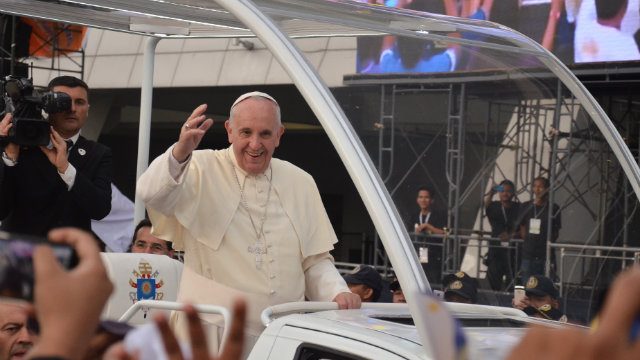SUMMARY
This is AI generated summarization, which may have errors. For context, always refer to the full article.

How well do you know the Pope?
Weeks before Pope Francis came, the Philippine media already had the spotlight on him, especially since the last papal visit to the country was way back in 1995.
There were all these features about him – from his childhood sweetheart to his top 10 most adorable moments with the crowd. From these alone, most would think they know him well enough.
When he finally arrived, the local mainstream media was in frenzy. My own Facebook newsfeed was flooded with these headlines: “Young Pinoys make rockstar Pope Francis top trending Twitter topic worldwide,” “Why Pope Francis was wearing a UST lanyard,” “What’s Inside the Pope’s Bag?” “99 things Pope Francis said in the Philippines.” Turn on the television, coverage was 24/7. It was virtually impossible to miss a thing.
‘Celebritization’ of the Pope?
When the media hullabaloo subsided, some friends started sharing foreign news about the Pope and his alleged tolerance of the abuses of the clergy and his controversial opinion about homosexual relationships. Most were disappointed while others were appalled. Was the pope they claimed to love the same person who declared that the LGBT movement was an anthropological setback? Hashtag: unbelievable.
It would have been ideal for people to research first if they genuinely wanted to know who leads the Catholic church. But in cases when these unpopular opinions are silenced by the overwhelming sentiment of the majority, it is media’s responsibility to provide history and context to help people come up with better judgment.
But judging from the TV fanfare and Thought Catalog-like articles, the local media is far from creating counter discourse, or even discourse to begin with.

The Pope was over-“celebritized” – his every word was quoted; every movement, a news piece. A veteran news anchor wasn’t able to help but comment whenever the Pope waved to the crowd, walked, and passed by – comments which did not add value or insight all.
Pope Francis was portrayed as the hero of the poor, the mighty adversary of the corrupt. The media wasn’t very keen on checking how his church practiced the same.
The whole Philippines was said to have been overjoyed with the papal visit, even news reporters were not subtle in expressing their support for the Pope. If you watched enough TV, surely you’ve encountered at least one reporter shouting how he or she loved the Pope.
Amusingly, there were even spin-off news – the right pronunciation of nunciature, #PapalVisit babies, and even the eye candy mass psalmist (ABS-CBN News actually has an extensive get-to-know more article). Except for a few news outlets, the local media coverage of the papal visit was pro-Church, sensationalized, and even superficial. And people are sharing these stories.
Ignored issues
I am not discounting the media when they report that people were moved by his speeches, and many lives were touched by his mere presence. He did visit the Philippines to share the promise of hope, especially to the victims of the typhoons. However, like other social institutions, the Pope and his church have a political agenda for his visit. But who bothered to ask?
“Is our media just staying true to the Filipino concept of courtesy?”
The Philippine Catholic church has been heavily criticized for its clergy’s lavish lifestyles and political abuses – yet it was never elaborated in media the whole time the Pope was championing to live in poverty. (READ: Veteran journalist unveils ‘Altar of Secrets’)
There are several facets we can explore that media did not pay attention to, such as who covered the bill for this ‘glorious’ 5-day feast? To the people who would say that it’s not the right time to discuss these issues, I think this is actually the best time to ask and be enlightened.
If the papal visit was indeed deliberately displayed in good light, for what end? Was media just being courteous? Or was it our colonial bias toward the Catholic church?
Media coverage
We can never be sure, but what is clear and glaring is poor media practice. The context was deemed irrelevant. The important questions were never asked. The contradictions were not questioned. I didn’t realize that the Philippine media could succumb to groupthink until last weekend. If anything, the opportunity to know the Pope better was lost. The supposed rich discourse to be inspired by diverse media perspectives is now moot as we bid goodbye to this week-long media spectacle.
We could have done it better – unbiased reporting is secular, taking into account the merits of his visits and the controversies of the institution he represents. After all, news should not deliver events in a vacuum – each affair is connected to a broader historical and societal context, and perceived from multiple world views. Good news spikes up web traffic, so do thought-provoking pieces.
Media can set public agenda and its framing of news can make or break personalities – if not institutions. With a lopsided media, the dominant will stay powerful and the status quo will remain unchallenged. We need more critical perspectives to incite more critical thought. – Rappler.com
Fatima is a digital and social media professional. She graduated magna cum laude with a degree in broadcast communication from the University of the Philippines.
Add a comment
How does this make you feel?
There are no comments yet. Add your comment to start the conversation.